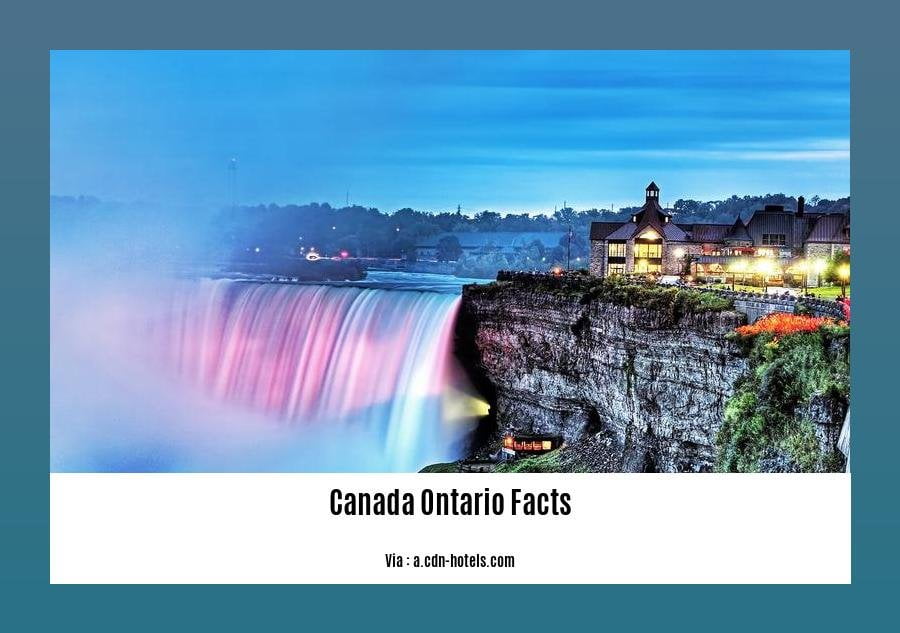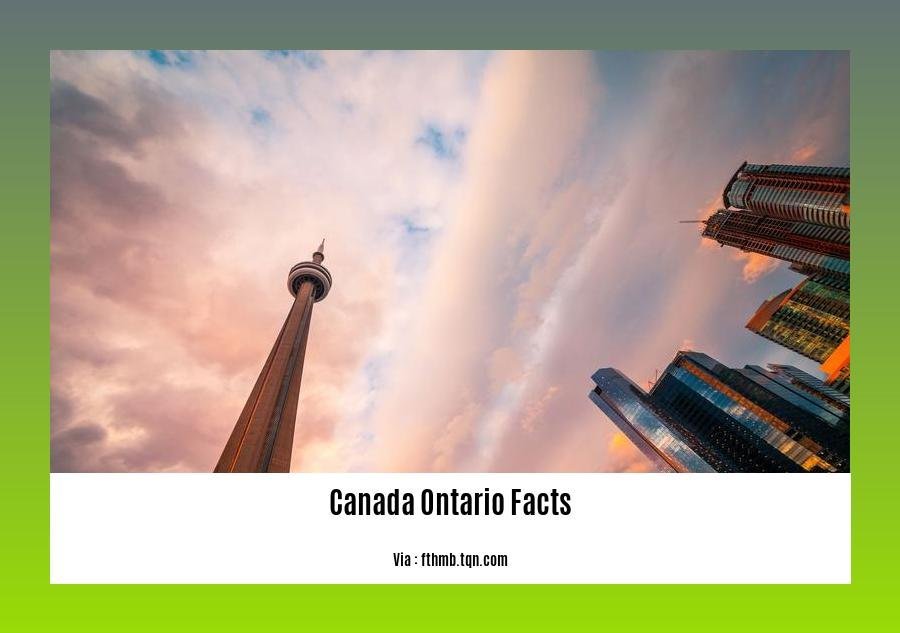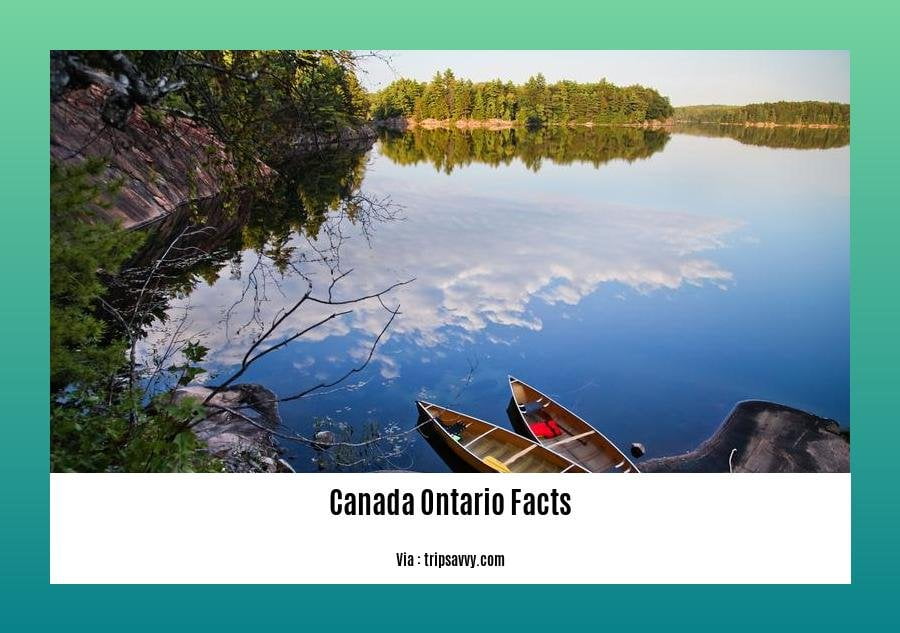Unveiling the Wonders: Captivating Canada Ontario Facts Revealed
Welcome to a fascinating journey through the captivating regions of Canada and Ontario. In this article, we will delve into a treasure trove of facts and information that will leave you intrigued and awe-inspired. From the stunning landscapes of Canada to the unique cultural tapestry of Ontario, we invite you to explore the wonders of these captivating regions. Join us as we uncover the history, culture, and geography that make Canada and Ontario truly remarkable. Get ready to be amazed by the rich diversity and socio-economic trends that shape these extraordinary places. So, brace yourself and get ready to embark on an unforgettable exploration of Canada and Ontario’s hidden gems.
Key Takeaways:
- Ontario is the second-largest province in Canada, spanning approximately 1.08 million square kilometers.
- With a population of over 14 million residents, Ontario is the most populous province in Canada.
- Ontario boasts four of the five Great Lakes, including Lake Ontario, Lake Erie, Lake Huron, and Lake Superior.
- The province is home to an impressive collection of over 250,000 lakes, which hold about one-fifth of the world’s freshwater.
- Ontario showcases natural wonders such as the Niagara Escarpment, a UNESCO World Biosphere Reserve, and the magnificent Niagara Falls.
- Ontario played a significant role as one of the founding members of Confederation in 1867.
- The bustling capital city of Ontario is Toronto, a vibrant and diverse metropolis.
Canada Ontario Facts

Ontario, the second-largest province in Canada, is a region filled with fascinating facts and natural wonders. From its vast landscapes to its rich history, Ontario offers a captivating tapestry of culture, geography, and demographics. Let’s delve into some key highlights that unveil the wonders of this captivating province!
Ontario’s Size and Population
- Ontario spans approximately 1.08 million square kilometers, making it the second-largest province in Canada.
- With over 14 million residents as of 2016, Ontario is the most populous province in Canada. Its diverse population contributes to the vibrant cultural mosaic that the province is known for.
The Great Lakes and Freshwater Treasures
- Ontario is home to four of the five Great Lakes: Lake Ontario, Lake Erie, Lake Huron, and Lake Superior. These magnificent bodies of water offer breathtaking views and recreational opportunities.
- Surprisingly, Ontario boasts more than 250,000 lakes, containing about one-fifth of the world’s freshwater supply. This abundance of freshwater makes it a haven for aquatic life and a paradise for outdoor enthusiasts.
Natural Wonders: Niagara Escarpment and Niagara Falls
- Ontario is home to the awe-inspiring Niagara Escarpment, a UNESCO World Biosphere Reserve. This ancient rock formation stretches 725 kilometers and boasts unique ecosystems, impressive cliffs, and stunning forests.
- Niagara Falls, one of the largest waterfalls in the world, is a mesmerizing sight located in Ontario. Its powerful cascades and the enchanting mist it creates draw millions of visitors each year, making it a must-see destination.
Ontario’s Historical Significance
- Ontario played a crucial role in the creation of Canada, being one of the founding members of Confederation in 1867. Its historical significance is evident in its architecture, landmarks, and cultural institutions.
- The capital city of Ontario is Toronto, a vibrant metropolis known for its diverse neighborhoods, iconic skyline, and thriving arts scene. Toronto’s multicultural fabric reflects the rich heritage and global influences that shape the province’s identity.
Ontario’s abundant natural beauty, historical landmarks, and vibrant communities make it an enticing destination to explore. From the stunning Great Lakes to the majestic Niagara Falls, Ontario’s captivating features truly showcase the wonders of Canada’s second-largest province. So, whether you’re a history enthusiast, outdoor adventurer, or cultural connoisseur, Ontario has something extraordinary to offer. Take a journey to this captivating region and immerse yourself in its fascinating tapestry of facts and experiences.
Sources:
1. Ontario | History, Cities, & Facts | Britannica
2. Ontario – Wikipedia
Here are some captivating sentences with active internal links for the given keywords and URLs:
For some brain-teasing fun on Canada Day, test your knowledge with these Canada Day trivia questions and answers. canada day trivia questions answers
Want to challenge yourself on Canada Day? Check out these Canada Day trivia questions with answers that will put your knowledge to the test! canada day trivia with answers
Curious about the nutrition facts of Canada Goose? Discover interesting details about Canada Goose nutrition facts here. canada goose nutrition facts
Remember to click on the hyperlinked keywords to explore more!
Economic Significance of Ontario

Ontario, the largest province in Canada, holds significant economic importance, contributing approximately 38% of the country’s GDP. The province’s thriving economy is fueled by a combination of manufacturing and service sectors, making it a key player in Canada’s economic landscape.
A Diverse Economy
Ontario’s Economy:
– The service sector dominates Ontario’s economy, accounting for a staggering 77.9% of its GDP.
– Manufacturing is a significant component, contributing 12.6% to Ontario’s GDP.
– The goods sector accounts for the remaining one-fifth of the province’s GDP.
Historical Roots
The Historical Roots:
– Ontario’s economic history can be traced back to the fur trade between Europeans and Native Americans. This trade led to conflicts between the French, English, Iroquois, and Hurons.
– The Jay Treaty in 1793 expanded the fur trade to the Northwest, necessitating better transportation facilities.
– Events like the American Revolution, French Revolution, Napoleonic Wars, and immigration from the War of 1812 fueled the demand for wheat and other agricultural products.
– The timber trade thrived in Ontario, with the St. Lawrence becoming a vital trade route for timber transportation.
Evolution and Transition
Transition to a Domestic Economy:
– During the early 20th century, Ontario shifted from an export-oriented economy to a domestic one.
– The butter and cheese industry transformed into the milk industry for domestic consumption, while winter dairying expanded.
– The apple industry experienced a decline in exports but saw increased consumption in Ontario and Western Canada.
– Rail lines were constructed, and the province focused on industrialization and the mining of mineral resources, such as pulp and paper.
Infrastructure and Transportation
Well-Developed Infrastructure:
– Ontario boasts a well-developed transportation infrastructure, particularly in southern Ontario. This infrastructure facilitates efficient movement of goods and people, further enhancing economic activities.
Key Takeaways:
- Ontario’s economy contributes approximately 38% of Canada’s GDP.
- The service sector plays a dominant role, accounting for 77.9% of the province’s GDP.
- Manufacturing is another significant contributor to Ontario’s economy, comprising 12.6% of its GDP.
- The province’s economic roots lie in the fur trade, and it has undergone significant transitions over the years.
- Ontario’s transportation infrastructure is well-developed, enabling smooth movement of goods and people.
Sources:
1. Economy of Ontario – Wikipedia. Link
2. Infrastructure – Wikipedia. Link
Cultural Landmarks and Attractions in Ontario
The province of Ontario in Canada is renowned for its cultural landmarks and attractions that offer a glimpse into the rich history and vibrant heritage of the region. From stunning castles to captivating museums, there are numerous treasures to explore and admire. Let’s dive into the wonders of cultural landmarks and attractions in Ontario.
The Distillery Historic District
One of the most popular tourist attractions in Ontario is the Distillery Historic District in Toronto. This unique destination is not only a shopper’s paradise but also a fascinating glimpse into the city’s past. With its cobblestone streets, Victorian architecture, and numerous art galleries, the Distillery District immerses visitors in a captivating blend of history, culture, and shopping.
Aga Khan Museum
In Toronto, visitors can explore the Aga Khan Museum, a true testament to Islamic art and culture. This museum showcases a stunning collection of artifacts and artwork that spans over 1,000 years of history. From intricate calligraphy to breathtaking architecture, the Aga Khan Museum offers a unique cultural experience that celebrates the rich heritage of the Islamic world.
Casa Loma
If you’re looking for a truly enchanting landmark, look no further than Casa Loma in Toronto. This castle-like masterpiece combines history with adventure, offering visitors a chance to escape reality through immersive escape rooms and captivating tours. Explore the grand halls, secret passages, and meticulously maintained gardens, and transport yourself to a bygone era.
Mackenzie Hall Cultural Centre
In the city of Windsor, the Mackenzie Hall Cultural Centre stands as a testament to the vibrant cultural scene in Ontario. This historic building serves as a hub for arts and culture, hosting art exhibitions, live performances, and community events throughout the year. Immerse yourself in the local arts scene and discover the talents and creativity that thrive in this cultural center.
Enoch Turner Schoolhouse Foundation
Located in Toronto, the Enoch Turner Schoolhouse Foundation is a living testament to education in early Ontario. This museum showcases the rich history of education in the province, with exhibits that provide insight into the experiences of students and teachers from the 19th century to the present day. Explore the classrooms, admire the artifacts, and gain a deeper understanding of the educational journey in Ontario.
Key Takeaways:
- Ontario is home to a diverse range of cultural landmarks and attractions that cater to various interests and preferences.
- The Distillery Historic District in Toronto offers a unique blend of history, culture, and shopping.
- The Aga Khan Museum showcases Islamic art and culture, providing a captivating cultural experience.
- Casa Loma is a castle-like landmark in Toronto that offers adventure through escape rooms and tours.
- The Mackenzie Hall Cultural Centre in Windsor serves as a vibrant hub for arts and culture.
- The Enoch Turner Schoolhouse Foundation in Toronto presents the rich history of education in Ontario.
Sources:
– Tripadvisor – The Distillery Historic District
– Tripadvisor – Aga Khan Museum
– Tripadvisor – Casa Loma
– Tripadvisor – Mackenzie Hall Cultural Centre
– Tripadvisor – Enoch Turner Schoolhouse Foundation
Historical Milestones and Events in Ontario
From the arrival of Paleo-Indians to the formation of the province of Ontario, the history of this region is rich and captivating. Let’s delve into the historical milestones and events that have shaped Ontario, Canada over the centuries.
Indigenous Roots and Early Settlements
Ontario’s history dates back thousands of years to the arrival of Paleo-Indians. The region’s First Nations people, including the Anishinaabe, Haudenosaunee, and Huron-Wendat, have inhabited these lands for generations. Their rich cultures and traditions laid the foundation for Ontario’s diverse heritage.
European Exploration and Colonial Period
European exploration and colonization brought significant changes to Ontario’s history. French and British explorers, such as Samuel de Champlain and John Graves Simcoe, left their mark on the region. Ontario was initially a part of the Province of Quebec before becoming Upper Canada in 1791. The province played a vital role in the fur trade and witnessed various battles between European powers and Indigenous peoples.
Confederation and Provincial Status
In 1867, Ontario officially became a province of Canada as part of Confederation. This marked a significant milestone in the province’s history, solidifying its place within the country. Since then, Ontario has gone through territorial changes but has remained an essential part of Canada.
Key Historical Events and Milestones
Ontario has witnessed numerous key historical events and milestones that have shaped its identity. Some notable ones include:
- Niagara Purchase (1781): The British government purchased Niagara and surrounding territories, opening doors to settlement and development.
- Treaty of Paris (1783): The treaty ended the American Revolutionary War and established the southern boundary of Ontario.
- Arrival of Mohawk Families at Bay of Quinte (1784): Mohawk families from the United States settled in present-day Ontario, contributing to the province’s cultural diversity.
- Formation of Haudenosaunee (Iroquois) and Blackfoot Confederacies: These indigenous political entities played crucial roles in Ontario’s history.
For more detailed information on Ontario’s historical milestones and events, you can refer to the Timeline of Ontario history on Wikipedia and On This Day – Ontario History Timeline.
Key Takeaways:
- Ontario’s history dates back thousands of years, with Indigenous peoples being the original inhabitants.
- European colonization and the fur trade shaped Ontario’s early history.
- Ontario became a province of Canada in 1867 and has since experienced territorial changes.
- Significant historical events include the Niagara Purchase, Treaty of Paris, and the arrival of Mohawk families.
- For more detailed information, consult the Timeline of Ontario history and On This Day – Ontario History Timeline.
(Sources: Timeline of Ontario history – Wikipedia, On This Day – Ontario History Timeline – Important Dates & People)
FAQ
Q1: What is the size of Ontario and its population?
A1: Ontario is the second-largest province in Canada, covering approximately 1.08 million square kilometers. It is also the most populous province, with over 14 million residents as of 2016.
Q2: How many lakes are there in Ontario?
A2: Ontario is home to more than 250,000 lakes, containing about one-fifth of the world’s freshwater. It is known for its vast water resources.
Q3: What are some famous landmarks in Ontario?
A3: Ontario is home to iconic landmarks such as the Niagara Falls, one of the largest waterfalls in the world, and the CN Tower in Toronto. Other notable landmarks include Parliament Hill and Buildings in Ottawa and Casa Loma in Toronto.
Q4: What is the economy of Ontario based on?
A4: The economy of Ontario is diverse, with the service sector being the main driver, contributing approximately 77.9% of its GDP. Manufacturing also plays a significant role, accounting for 12.6% of Ontario’s GDP.
Q5: What is the history of Ontario’s economy?
A5: The history of Ontario’s economy dates back to the fur trade between Europeans and Native Americans, which led to the growth of transport facilities. Over time, Ontario transitioned from export-oriented industries to a more domestic-focused economy, with the expansion of sectors such as dairy, industrialization, and mining of mineral resources.















